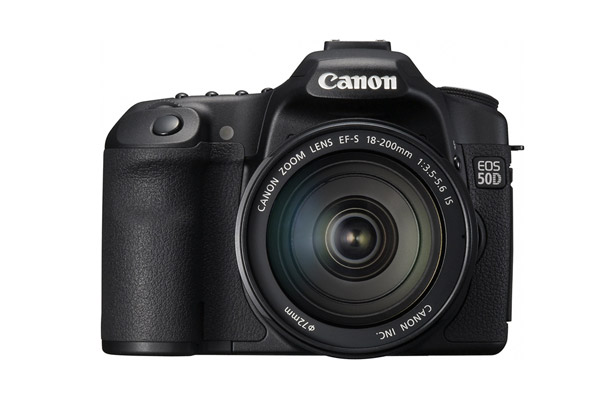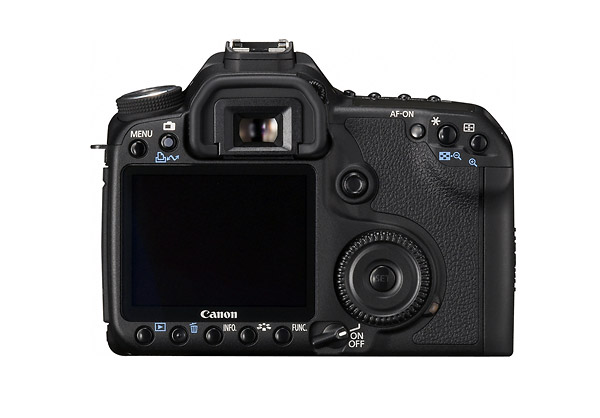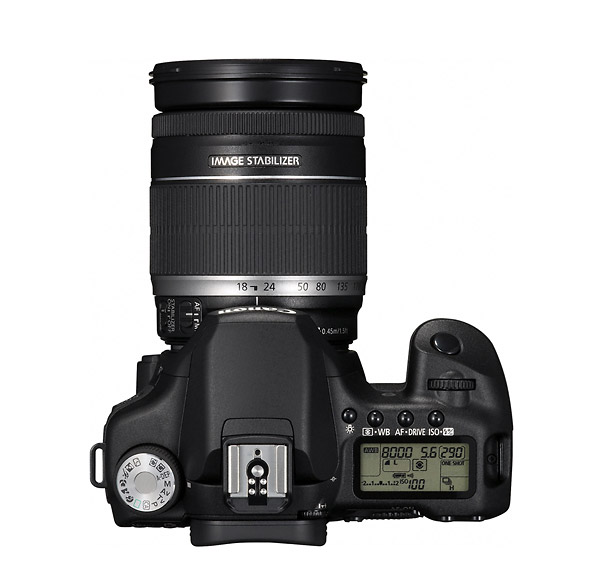CANON U.S.A. STIMULATES THE CREATIVITY OF EXPERIENCED PHOTOGRAPHERS WITH THE INTRODUCTION OF THE NEW EOS 50D DIGITAL SLR CAMERA
Canon’s New DIGIC 4 Image Processor Fuels the 15.1 Megapixel Resolution, Expanded ISO Range and Enhanced Noise Reduction of the New EOS 50D Digital SLR
LAKE SUCCESS, N.Y., August 26, 2008 – With the demand for digital SLR cameras reaching unprecedented levels, Canon U.S.A., Inc., a leader in digital imaging, is answering the call with the announcement of the next evolution in advanced amateur digital SLR photography, the EOS 50D Digital SLR Camera with 15.1 megapixel resolution and Canon’s new DIGIC 4 image processor. Designed to offer extraordinary quality and image control for the advanced photographer with a passion for the art, the Canon EOS 50D Digital SLR camera includes an expanded ISO range, improved noise reduction, and in-camera photo editing features. Canon has loaded the EOS 50D camera with a number of enhancements and some trickle-down technology from Canon’s professional Digital SLR cameras, as well as a new Creative Auto Mode (CA) that gives users more creative flexibility to make image setting adjustments conveniently without the need to be a photo expert.
Canon has built upon the success of the popular EOS 40D model – which will remain in Canon’s line – with the EOS 50D Digital SLR camera. Expected to be the camera body of choice for advanced amateur photographers this holiday season, the Canon EOS 50D Digital SLR camera carries over the EOS 40D’s 14-bit Analog-to-Digital conversion process for smooth tones, and also includes enhanced noise reduction, especially at higher ISO ranges which will help bring those romantic nighttime shots into greater focus and clarity. Capable of shooting 6.3 frames per second (fps), the EOS 50D Digital SLR camera is ideal for shooting everything from beautiful night landscapes to fast-action sports.
“Advanced amateur photographers blur the line between the hobbyist and the professional, looking for professional features and capabilities in their equipment that will allow them to capture that awe-inspiring image. Canon is constantly striving to provide these shooters with the most advanced imaging technology, like the new EOS 50D Digital SLR camera, to fuel their passion for photography, and help them achieve their creative potential,” stated Yuichi Ishizuka, senior vice president and general manager, Consumer Imaging Group, Canon U.S.A.
Improved Image Quality
The EOS 50D Digital SLR camera’s 15.1-megapixel CMOS APS-C size image sensor has been improved thanks to the use of newly designed gapless microlenses over each pixel to reduce noise and expand sensitivity up to ISO 12800. The faster processing speed of the camera’s DIGIC 4 image processor contributes to the fast 6.3 frame-per-second (fps) continuous shooting capability (for bursts of up to 90 Large/Fine JPEGs or 16 RAW images on a UDMA CF card), to give shooters the tools they need to capture that perfect moment in perfect clarity.
The Canon EOS 50D camera provides ISO speeds from ISO 100 up to ISO 3200 in 1/3-stop increments, along with two high-speed settings – H1 and H2 – of ISO 6400 and ISO 12800, respectively. Along with a wide ISO range, Canon gives shooters more tools to help maximize clarity and color. The EOS 50D Digital SLR camera offers multiple levels of noise reduction during high-speed shooting. Users can choose from one of four settings– Standard/Weak/Strong/None – to help reduce digital noise that can result from poor lighting conditions.
As part of the camera’s internal image processing, the Canon EOS 50D Digital SLR camera conducts peripheral illumination correction, which automatically evens brightness across the image field, making an image of a blue sky even toned throughout, a function previously accomplished through post-processing software on a personal computer. Thanks largely to the DIGIC 4 processor, this automatic adjustment can be made in-camera during shooting with JPEG images or corrected in post-photoshoot processing with RAW images through Canon’s Digital Photo Professional (DPP) software, which is supplied at no extra charge.
Helping to ensure each picture’s subject is clearly visible, Canon’s enhanced Auto Lighting Optimizer analyzes the brightness of subjects and automatically adjusts dark images so that they appear brighter, perfect for subjects in shade or in backlit situations. The Auto Lighting Optimizer on the EOS 50D Digital SLR camera has been updated not only to optimize images while they are being taken, but can also optimize images post-capture, during playback, to help ensure the subject of each image does not appear too dark. This is especially helpful when an amateur photographer uses the camera, because post-capture enhancement can help maximize image quality without the need of a computer.
A significant upgrade to the Canon EOS 50D camera is its large, clear 3.0-inch Clear View LCD screen which features 920,000 dot/VGA resolution, four times the pixel count of the EOS 40D camera’s screen, for better clarity and color. To help show off those fantastic shots, the EOS 50D camera includes an HDMI (High-Definition Multimedia Interface) output to display crisp, clear images on a High-Definition TV. The EOS 50D recognizes the needs of today’s photographers, and the faster processing speed of the DIGIC 4 processor helps support UDMA cards for faster writing of image files.
The camera is also equipped with a high-performance viewfinder featuring 0.95x magnification and the same high-performance Autofocus (AF) system as the EOS 40D camera with nine cross-type sensors for accurate target subject acquisition with lenses possessing maximum apertures of f/5.6 or faster and a high-precision diagonal center cross-type AF point that’s effective with f/2.8 and faster lenses, helping photographers ensure better focus of their targets. The AF Microadjustment feature, originally introduced last year with the Canon EOS-1D Mark III professional digital SLR camera, has also been added to the EOS 50D for maximum control over focusing precision.
Canon Gets Creative For Advancing Amateurs
Canon is taking steps to give advanced amateurs more flexibility with a new “CA” Creative Full Auto setting on the EOS 50D Digital SLR camera’s mode dial. This new setting goes a step beyond Full Auto, by allowing users to make adjustments before shooting while still in an Automatic mode, without needing to know the meaning of technical terms such as aperture, shutter speed, etc. In this mode, the camera menu on the back screen spells out options in common language for average photo enthusiasts, allowing them to “blur the background” or “lighten or darken the image.” These easy-to-comprehend image options will help amateur photographers improve the shots they are capable of taking, while helping them learn new techniques. When in the new CA mode, users will be able to adjust flash settings, brighten or darken images, blur the background, set the camera’s drive mode, and select a picture style directly on the camera’s LCD screen.
Better Live View
For photographers who prefer to frame their shots using the camera’s 3.0-inch Clear View LCD screen, Canon has improved the Live View function of the EOS 50D Digital SLR camera to include “Quick Mode AF,” “Live Mode AF,” and “Face Detection Live Mode AF” that detects up to 35 individual forward-looking faces for better focus and clarity when taking group or portrait shots. The camera’s Quick Mode AF setting flips the mirror down and carries out regular phase-detection autofocus, while the Live Mode AF and Face Detection Live Mode AF use the camera’s CMOS image sensor for contrast detection autofocus. Two detailed grid displays have also been added to Live View shooting as optional settings for easier composition.
Two Small RAW Formats
In addition to the RAW and JPEG image capture modes that photographers are accustomed to, the EOS 50D Digital SLR camera now offers more manageable resolution settings and file sizes with two sRAW recording formats, sRAW1 and sRAW2. At the sRAW1 setting, resolution is 7.1 megapixels with a file size that is approximately 25 percent smaller than a standard 15.1 megapixel RAW image. With the sRAW2 setting, resolution is 3.8 megapixels at less than half the file size of a standard RAW image, retaining all of the flexibility and creative possibilities associated with full-size, conventional RAW images. The EOS 50D is the first Canon Digital SLR that allows the use of RAW and sRAW settings in Basic Zone as well as Creative Zone shooting modes, even further improving the camera’s flexibility.
EOS Integrated Cleaning System
The Self-Cleaning Sensor Unit for the Canon EOS 50D has also been upgraded and now includes a fluorine coating on the low-pass filter for better dust resistance. The Self-Cleaning Sensor Unit uses ultrasonic vibrations to shake dust particles off of the low-pass filter in front of the sensor each time the camera is powered up or shut down. The second part of the system includes a software component where sensor spots are mapped and saved as Dust Delete Data that is attached to the image file for removal during post processing using Canon’s DPP software.
Pricing and Availability
The EOS 50D is compatible with the full lineup of Canon EF lenses as well as the Company’s ever-growing line of affordable EF-S lenses created specifically for Canon Digital SLRs with APS-C size image sensors. The Canon EOS 50D Digital SLR camera is scheduled for October delivery and will be sold in a body-only configuration at an estimated selling price of $1,399.00*. It will additionally be offered in a kit version with Canon’s EF 28-135mm f/3.5-5.6 IS USM zoom lens at an estimated selling price of $1,599.00*.
New EF-S 18-200mm f/3.5-5.6 IS Lens
Canon has answered the call from advanced amateur photographers looking for a solid all-around lens with the introduction of the new EF-S 18-200mm f/3.5-5.6 IS zoom lens. With an incredible focal length range equivalent to 29-320mm in the 35mm format, the new EF-S 18-200mm lens will make an excellent addition to any camera bag, and it gives shooters a great lens to capture both standard as well as telephoto images. The new lens features Canon’s built in Optical Image Stabilization system which gives the equivalent effect of a shutter speed roughly 4 steps faster, for better image clarity, even in shaky shooting conditions. With a minimum focusing distance of 0.45m/1.5 ft. at all zoom settings, this new lens should prove to be ideal for those situations where swapping lenses isn’t an option. An ideal complement to the EOS 50D SLR camera and all other EF-S compatible EOS SLR cameras, the EF-S 18-200mm f/3.5-5.6 IS lens is scheduled to be in stores this October at an estimated selling price of $699.00*.
About Canon U.S.A., Inc.
Canon U.S.A., Inc. delivers consumer, business-to-business, and industrial imaging solutions. Its parent company, Canon Inc. (NYSE:CAJ), a top patent holder of technology, ranked third overall in the U.S. in 2007†, with global revenues of $39.3 billion, is listed as one of Fortune’s Most Admired Companies in America and is on the 2007 BusinessWeek list of “Top 100 Brands.” To keep apprised of the latest news from Canon U.S.A., sign up for the Company’s RSS news feed by visiting www.usa.canon.com/pressroom.
Related Content:
Canon Digital SLR User Reviews
All Canon User Reviews
Canon Cameras Forum
Digital SLR Forum
More Canon News And Articles
Canon Cameras Web Site





yes please!
more reason to keep all my Canon gear!
can’t wait to see if the paper concept meets expectation (or even exceeds!).
15MP w/ better image quality?
Faster auto focus and ludicrous speed ISO!
…BRING IT ON!
if it’s all it sounds, i’ll be putting anything that’s not held down around the house, up for hock!
now if they’d only throw in some in-body IS…
Based on what I’ve seen from cameras over the past year or so, I think we have reason to believe it will be as good as it looks on paper. I doubt we’ll see in-body image stabilization from Canon or Nikon, though.
Anybody wanna buy my 40D?
It looks like it has real potential, but two or three things really stand out to me
1) the 40D’s AF system is carried over practically unchanged. Rob Galbraith, a very well known Canon shooter, has recently put out an article detailing what he feels are some serious shortcomings of the 40D AF system for many sports/professional applications. This is the same guy who has been working tirelessly with Canon to try and find the problems with and fix the 1D mark III for a good year now. I would have hoped for their sake a more powerful AF system sans issues would have been deployed.
2) I’ve been looking at Canon’s image samples. There is a ton of detail without much sharpening to be added in the low ISO portrait image supplied, however this indicates to me the possibility of a very weak anti-aliasing filter.
The High ISO sample is ISO 1600 at 1/8000sec f/8.0 on a 600mm f/4L IS. This is a very good lens, yet the image seems to lack any critical sharpness. Even attempts to sharpen simply produce haloes and artifacts and noise without much actual sharpening. I thought this must have indicated a focus error, until I looked at the side mirrors on the car that is the subject of the photo. I saw aliasing artifacts. So it looks like there may well be some pretty heavy internal noise reduction going on, possibly even beyond that which can be selected in the camera.
I wasn’t impressed by the performance of the ISO 400 night scene though.
I’ll reserve final judgement until it gets into capable hands. Canon’s image samples are taken by really awful photographers most of the time for some reason.
3) I think there’s a real chance dynamic range may suffer if there truly is any significant amount of NR needed to keep the images clean.
Pingback: Nikon D90 vs. Canon EOS 50D vs....
I’ve been waiting patiently for a upgrade to my Rebel XT…. haven’t been motivated enough to take a leap. But, this 50D will probably push me over the edge.
Pingback: Canon EOS 7D Teaser
Pingback: Nikon D90 - Now With Video!
NIKON IS GOOD but, CANON is better in some aspects… Just the price s–cks!!!
I have used the 50D for quite some time now (http://www.paulmanoian.com/) and there’s no denying the images it produces are much softer than the 40D at the pixel level. This is to be expected in a camera that bumps the resolution up 50% on the same-sized sensor simply because there is less wiggle room. It is essential to use top quality optics with this body if you want to take advantage of the higher levels of detail the body is capable of capturing. Images captured with lenses, that were considered “decent” on other bodies, may appear fuzzy since the optics are not capable of focusing as sharply as needed. My “L” lenses do very well. My other lenses, well, I sold them since this body REQUIRES pinpoint focusing capabilities. If the lens provides a less-than-perfect image to the sensor, the 15MP sensor will definitely capture a blurry image.